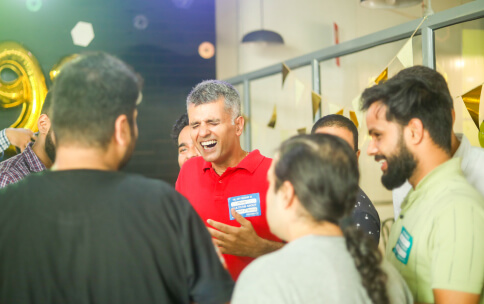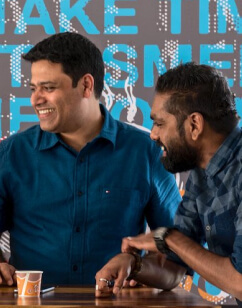Growth doesn’t have to be daunting, it can be fun and legendary!
“Becoming isn’t about arriving somewhere or achieving a certain aim. I see it instead as forward motion, a means of evolving, a way to reach continuously toward a better self. The journey doesn’t end.”
– Michelle Obama, in her book Becoming
When you think about it, Michelle Obama in that quote is describing growth. After all, growth is a journey of constant self improvement, with no deadline on when it needs to end. The desire to grow, either personally or at an organisational level never really stops.
And the best part is that growth is always evolutionary. So whether you achieve the growth target or not, you still learn and evolve as a person.
Growth means different things to different people and organisations.
Growth is not an idea that’s restricted to start-ups and small companies. Let us illustrate this point:
Imagine you’re a solo entrepreneur, for you growth possibly means starting from one person (you) and building up to a team of 10, while at the same time going from serving two clients to 20 clients.
For a small company it could mean generating a higher revenue than they did in the last quarter.
An emerging brand might look at growth as being able to reach 3X the customer base that it managed in the previous year.
Even the largest enterprises are chasing growth – either through expansion into new markets or diversifying their product portfolio.
Essentially, while the idea of growth might be different for different people, the joy derived from growth is universal.
For continuous growth, you need everyone pulling together
“Growth hacking is a team effort, the greatest successes come from combining programming know-how with expertise in data analytics and strong marketing experience, and very few individuals are proficient in all of these skills,” writes Sean Ellis, the pioneer of growth marketing, in his book Hacking Growth.
If you haven’t quite got what he’s trying to say, we’ll break it down for you in one word: teamwork! The thing about growth is, you’re constantly chasing macro targets. It’s about moving the needle by a considerable margin, on things that impact the entire business. It’s unrealistic to expect one person to be able to increase profits or market share. That needs the entire organisation to come together and put their energy into chasing after the specific growth target.
Think of growth as a puzzle, and each team as one piece that connects with the other to make up the final picture.
The Brand Team needs to first think of the best way to communicate the overall offering to the end user.
The Creatives need to work on delivering this message in the most attractive way, that gets a user interested.
The Marketing Team needs to know where to target their users. Once locked in, they need to work with the Ad Serving team to ensure the message reaches millions of potential users.
While this happens, someone needs to ensure the user journey from seeing an ad and making a decision to buy.
Incidentally, this is one of the reasons companies now flock to Coworking spaces. It’s essentially a hub of thousands of differently skilled workers under one roof. And if you’re missing pieces in your puzzle, all you have to do is stroll around the work space and connect with the ones who will fit in perfectly.
A race without a finish line
We know you want to rejoice, do nothing, and simply gaze over your kingdom that’s now much bigger than it was last year, but we’ve got bad news for you. Growth. Never. Stops.
It’s like a race, where you’re constantly trying to beat your previous time record, or the previous position you were in. Except, this race has no finish line… and let’s be honest, a race without a finish line can be scary. It can disillusion the people that make up the workforce as easily as it once motivated them.
Earl Nightingale, an American author and motivational speaker once said “People with goals succeed because they know where they’re going.”
Well, what happens when that goal changes every single quarter. What happens when you’ve hit the targets for the year, and at the success party the boss announces bigger targets for the upcoming year. Fear grips you, the sense of achievement washes away and a sense of anxiety takes over. What’s the point of grinding so hard and achieving the aggressive targets, if the goal post is going to shift the moment you do.
This is what makes most employees detest a culture of constant growth. It’s a feeling of ‘I have to keep absorbing huge amounts of pressure, for a company that’s never satisfied with the growth they’ve achieved. How does that help me?’
Growth can only be constant if it helps your employees grow
The most crucial element of creating a growth culture that lasts, is aligning personal growth with company growth. Ask yourself this, did your employees grow every time the company grew? 3X revenue is great, but did that result in a sizeable jump in your employee’s salary? Or were you able to offer them a new designation that aptly rewarded them for their contribution to the growth?
Sometimes it isn’t just about the salary or the title. It’s about your employee’s general wellness. An exhausted, demotivated employee will never be able to work towards growth… no matter what salary or designation you give them. Here’s where organisations need to look into programs that boost employee wellness.
Have you invested in an unlimited leave policy that allows employees to take as many days off whenever they want to rest and recharge. What about flexible work hours? Do you really need them to clock in eight hours every single day, or do you understand that some days could be as long as 12, and others as short as four.
How about a Hybrid Work model that allows your employees to choose where they work from, maybe three days in an office and two days from the comforts of their home. Better still, five days from wherever they like, maybe their preferred choice is to book a co-working space near their place.
One, or all of this is absolutely fine, since it leads to the larger objective of driving constant growth for your company. Salary, designation, work-life balance… these are some key personal goals for your employees. Make sure you have this covered before chasing after year-on-year growth.
By the way, growth can be a lot of fun, and it can be legendary.
The joy derived from growth can be immense for everyone involved in the process. It’s massive for an organisation to meet their growth targets. It can be equally rewarding for the employees who make up the company, provided the right environment has been set up for it. The right growth strategy and environment won’t just lead to you meeting your targets, it could also set you up as a thought leader in the space, it can make you the ones that everyone else wants to emulate.
A fun example of this is Dutch Football’s most famous tactic – Total Football. It’s possibly the most talked about growth strategy. It happened in the 1970s, but here we are in 2023 with football managers trying to emulate parts of it and still winning titles. The strategy was this: Any outfield player can take on the role of any other player in the team. Meaning when the situation demanded, a defender could become an attacker, an attacker could switch to a midfielder, a midfielder could take the place of a defender. Whenever anyone moved out of position, a player no matter what original position they were in, would swoop in to fill the gap. Total Football = Total Understanding of the team’s goal.
The result? A Dutch team that wasn’t a favourite to start with stormed into the final of the World Cup in 1974 and 1978!
It worked because everyone bought into the system, and it worked because everyone enjoyed the system. No one was bucketed into one skill set, no one was told they would never do anything different. Everyone improved on their complete footballing skills, not just their defending or attacking skills. This is how personal growth and development lead to the company (Dutch football team) growing as a whole. Total Football is now a legend, and your growth strategy can become one as well. Just remember to keep your personnel at the heart of it.
Great, now can you sum this up in three quick passes?
- Growth means different things to different people, depending on where their starting point is.
- Collaboration is at the heart of every growth strategy. Remember to move the needle, you need everyone to push.
- While growth has a starting point, it never has a finish line… this is where it can get daunting for your resources,you must ensure their personal goals are always aligned with the company’s goals. This can actually make growth very rewarding for each employee.


















